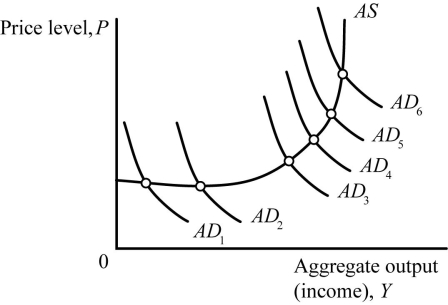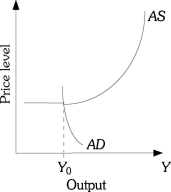A) AD; horizontal
B) AD; vertical
C) AS; horizontal
D) AS; vertical
Correct Answer

verified
Correct Answer
verified
True/False
An increase in aggregate supply causes stagflation.
Correct Answer

verified
Correct Answer
verified
True/False
If the AD curve is relatively flat, the Fed is willing to accept large changes in output to keep the price level stable.
Correct Answer

verified
Correct Answer
verified
True/False
Inflation due to a decrease in aggregate demand is called demand-pull inflation.
Correct Answer

verified
Correct Answer
verified
True/False
When the economy is on the flat part of the AS curve, there is very little crowding out of planned investment.
Correct Answer

verified
Correct Answer
verified
Multiple Choice
Refer to the information provided in Figure 12.2 below to answer the questions that follow.  Figure 12.2
-Refer to Figure 12.2. The output multiplier is smallest when the aggregate demand curve shifts from
Figure 12.2
-Refer to Figure 12.2. The output multiplier is smallest when the aggregate demand curve shifts from
A) AD1 to AD2.
B) AD3 to AD4.
C) AD5 to AD6.
D) The output multiplier is the same for all AD curve shifts shown in the figure.
Correct Answer

verified
Correct Answer
verified
True/False
If the long-run aggregate supply curve is vertical, fiscal policy will have no effect on the price level.
Correct Answer

verified
Correct Answer
verified
Multiple Choice
Since 1970, the Fed generally ________ the interest rate when inflation was ________.
A) raised; high
B) raised; low
C) lowered; high
D) The Fed has maintained a stable interest rate since 1970.
Correct Answer

verified
Correct Answer
verified
Multiple Choice
Stagflation is an economic condition characterized by ________ unemployment and ________ inflation.
A) high; high
B) high; low
C) low; high
D) low; low
Correct Answer

verified
Correct Answer
verified
Multiple Choice
If the economy is on the steep portion of the AS curve and taxes decrease, ________ crowds out ________.
A) consumption; planned investment
B) government spending; planned investment
C) planned investment; consumption
D) planned investment; government spending
Correct Answer

verified
Correct Answer
verified
Multiple Choice
A sudden increase in aggregate demand causes a ________ inflation and ________ output.
A) demand-pull; lower
B) cost-push; higher
C) demand-pull; higher
D) cost-push; lower
Correct Answer

verified
Correct Answer
verified
Multiple Choice
A decrease in the Z factors represents
A) a tightening of monetary policy.
B) an easing of monetary policy.
C) an expansionary fiscal policy.
D) a contractionary fiscal policy.
Correct Answer

verified
Correct Answer
verified
True/False
In 2007, the Fed engaged in inflation targeting when it lowered the interest rate in anticipation of a recession.
Correct Answer

verified
Correct Answer
verified
True/False
In a binding situation, the interest rate is always zero.
Correct Answer

verified
Correct Answer
verified
Multiple Choice
Economic policies are effective at changing output when
A) the economy is not producing at capacity.
B) the economy is producing at its potential output.
C) the unemployment rate is at the natural rate.
D) the aggregate supply curve is vertical.
Correct Answer

verified
Correct Answer
verified
Multiple Choice
If the Fed has a strong preference for stable prices relative to output, the ________ curve is relatively ________.
A) AD; steep
B) AD; flat
C) AS; steep
D) AS; flat
Correct Answer

verified
Correct Answer
verified
Multiple Choice
A binding situation occurred during the recession of
A) 1974-1975.
B) 1980-1982.
C) 1990-1991.
D) 2008-2009.
Correct Answer

verified
Correct Answer
verified
Multiple Choice
The objective of a contractionary fiscal policy is to
A) reduce unemployment.
B) increase growth in output.
C) reduce inflation.
D) increase stagflation.
Correct Answer

verified
Correct Answer
verified
True/False
During the recession of 1980-1982, output, the inflation rate, and the interest rate all increased.
Correct Answer

verified
Correct Answer
verified
Multiple Choice
Refer to the information provided in Figure 12.4 below to answer the questions that follow.  Figure 12.4
-Refer to Figure 12.4. If the economy is currently at the intersection of AS and AD, stagflation would be caused by
Figure 12.4
-Refer to Figure 12.4. If the economy is currently at the intersection of AS and AD, stagflation would be caused by
A) an increase in AS.
B) a decrease in AS.
C) an increase in AD.
D) a decrease in AD.
Correct Answer

verified
Correct Answer
verified
Showing 101 - 120 of 200
Related Exams